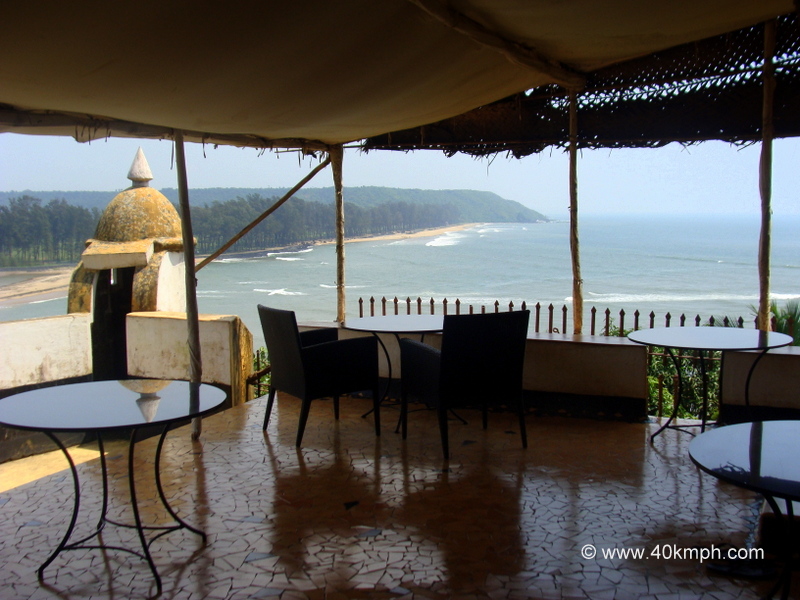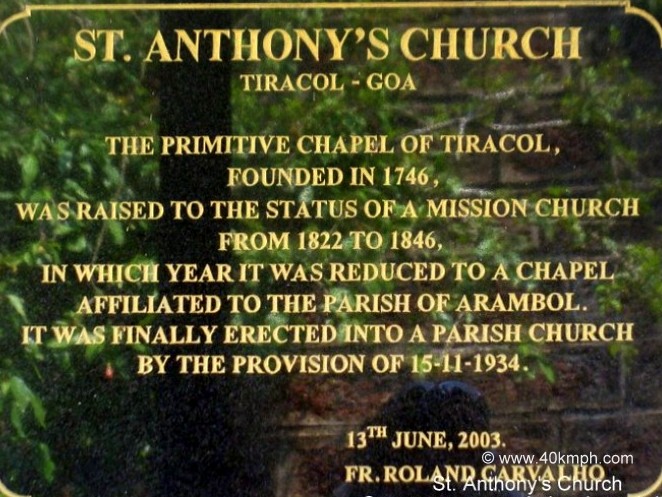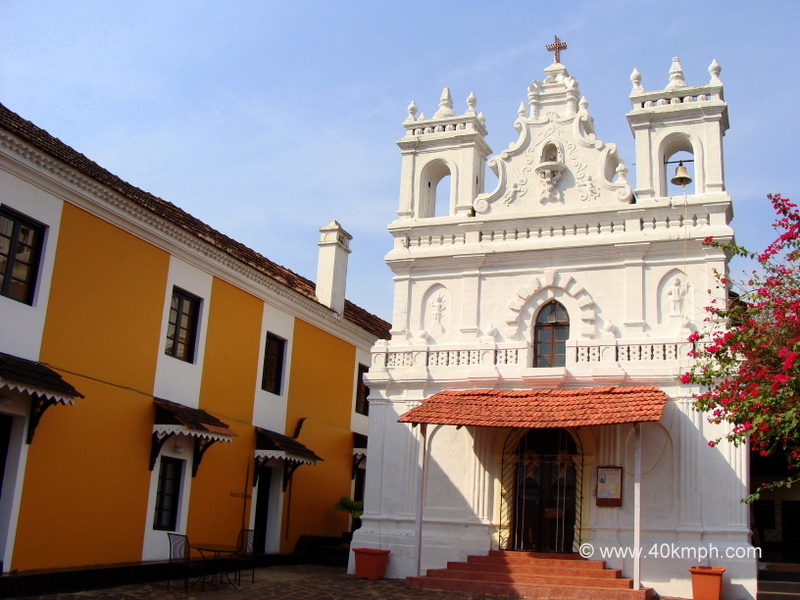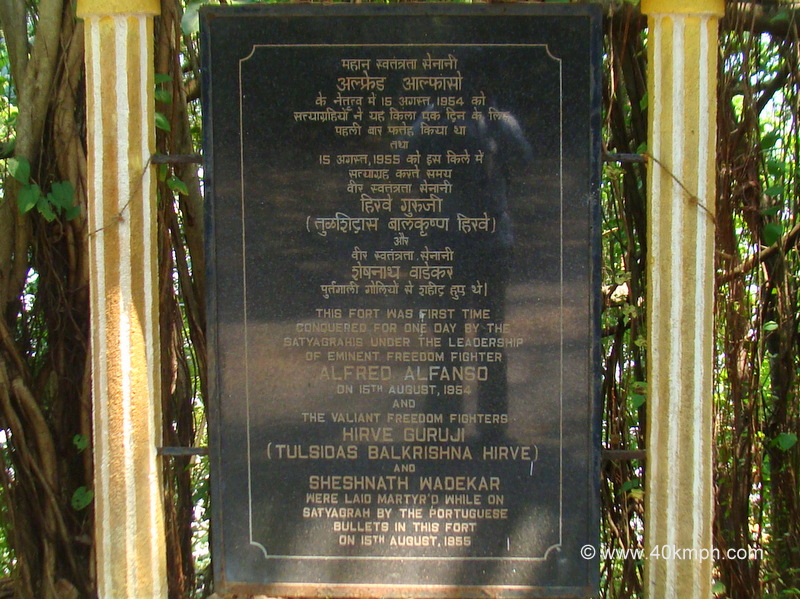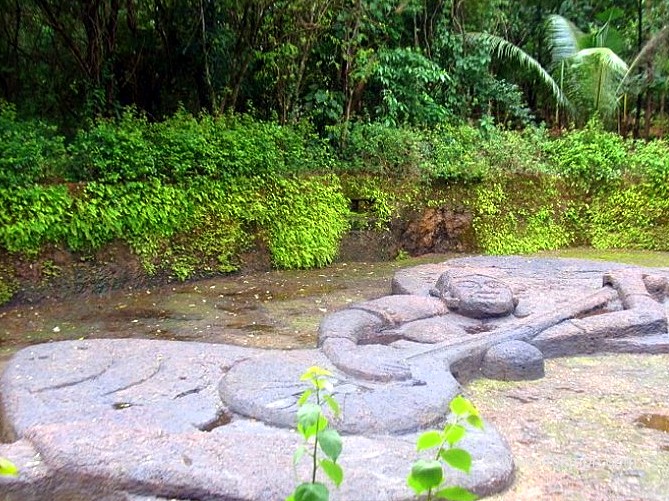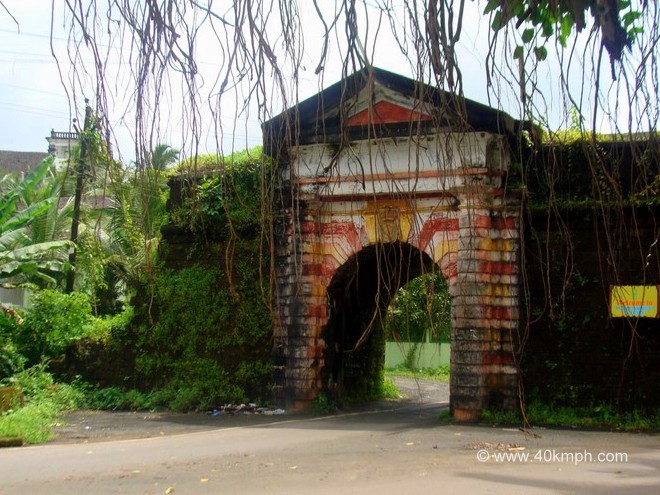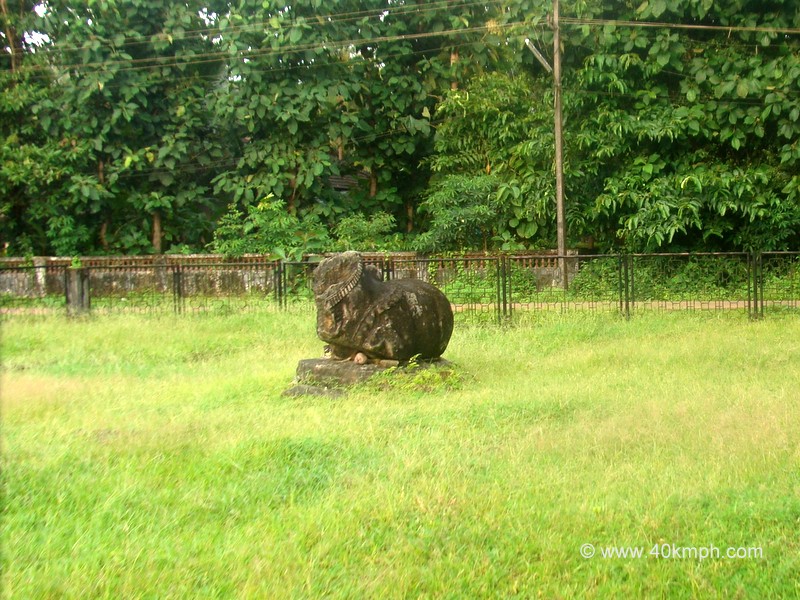Click to learn more about Fort Tiracol Heritage Hotel.
About: St. Anthony’s Church, Tiracol – Founded in 1746
1746 में स्थापित तिराकोल के प्राचीन चैपल को 1822 से 1846 तक एक मिशन चर्च का दर्जा दिया गया था, जिस वर्ष इसे अरामबोल के पैरिश से संबद्ध एक चैपल में बदल दिया गया था। अंततः 15-11-1934 के प्रावधान द्वारा इसे एक पैरिश चर्च के रूप में स्थापित किया गया।
13 जून, 2003
फादर रोलैंड कार्वाल्हो
(English to Hindi Translation by Google Translate)
St. Anthony’s Church, Fort Tiracol Heritage Hotel
Click to learn more about Fort Tiracol Heritage Hotel.
About: Fort Tiracol – Heritage Hotel
Click to learn more about Fort Tiracol.
Casa Araujo Alvares (Loutolim) – 250 Year Old Mansion
Casa Araujo Alvares, after visiting Big Foot. I saw visitors talking about a mansion and a few crossing the road lined up to enter. I inquired and the guard said: I have to buy a ticket from the Big Foot ticket counter to enter.
Visiting Hours: 9:00 am to 1:00 pm / 2:00 pm to 6:00 pm
(Tour every 15 minutes)
Rs. 100/person was paid.
Silence please – The guard requested.
We proceeded inside the mansion. A pre-recorded sound with lighting effects. Dr. Salvador Eufemiano Araujo Alvares, 250 years old home. Let us view the traditional inheritance through the eyes of the modern age.
The narration continues…
– The cold and silent environment around displays the mindset of those days people
– Hat and walking stick are the Portuguese fashion those days
– Women used to carry a colorful umbrella
– The stand for Hats on the left-hand side of the entrance
The reason: When a guest enters the house, the left hand is used to place the Hat on top of the stand and the right hand for a welcome gesture
– palki (palanquin) of those days – conveyance mode
– The main door once opened during sunrise is shut only at night hours
– The chapel inside the house is close to the inner-entrance gate
– 6:30 pm – The church bell and family members gather around the chapel to pray
– The Home-Office of Dr. Salvador Eufemiano Araujo Alvares, advocate by profession
The humble, down-to-earth person is always helpful to the poor to settle disputes outside the court with mutual talks between the parties
– Portuguese law books displayed within a wooden almirah
– Portuguese law takes care of women’s rights, especially during those days
– wooden almirah/furniture with hidden/secret spaces
– The long arms of a wooden chair so that a person can put his or her legs to relax
– hand-written scripts
– The bedroom area with four pillars bed
– Master bedroom windows/doors decorated with beautiful carvings
– The wooden ceiling for coolness
– 150-year-old bed-sheet gifted by Lara Gomes
– Commode was used within the bedroom during the night hours because in those days bathroom/latrine was at the back of the home
But nowadays bathroom/latrine part of living-area
– Chini Mitti (china clay) Basin and soap case from England used during face-wash
– room for kids and maid to take care of them
And Toys from those days
– Windows are not covered with glass but with a sea-shell
Plenty of seashells were available within Goa those days
– Walls with gun holes
Professional shooters were hired for defense against the dacoity of the Rane clan
– Secret places to hide
– Barrel to store wine specially brought by Portuguese people from their native places
– Feni – The Goan drink was used for cold/cough and stomach pain
– The face-mask – people used to wear it during festivals and during local plays
– hanging charpai (cot) on the wall used if a guest visits during night hours
– The huge big kitchen and the underground location to store monthly ration. Closed currently due to snakes/insects
– Keema (traditional meat) preparing machine/wooden boxes to store spices/big matkas (earthen pot) used as an oven
– 150 feet deep Well was dug before the house was built so that during construction plenty of water is available
Note: The well was used both by the owner of the house as well as nearby villagers
– Close to the well is a horse-cart/bull-cart and bicycle
– Aangan (an open courtyard) within the home to be used to dry fish or any other purpose or to grow chili/lemon
– A place for meditation and more than 1000 Lord Ganesha idols collected by one of the current inheritors of the house – Shri Maendra. The idol is of different sizes but the smallest is as small as rice and is made of mud as well as gold
– Adjustable dining table for 24 people
– Chandelier/Glasses from Belgium
– The German lampshade. To burn the lamp half oil and half water was used during those days but nowadays it is replaced with electricity
And many more…
Wonderful history – Thanks to the current owners of the ancestral mansion. One should not miss the traditional inheritance if visiting Goa. Casa Araujo Alvares is situated at Loutolim in Salcette taluka of the South Goa district.
Longest Laterite Sculpture in India – Mirabai at Big Foot, Loutolim
Sahakari Spice Farm (Curti) – 300-Year-Old Plantation
Caves – village Curti, Khandepar, Ponda, and I am not sure about the name though I visited it once. The next day during the search – Caves within Ponda or somewhat search somehow I found another piece of information i.e., Sahakari Spice Farm, interesting as per someone’s blog. The farm I guessed close to the cave’s location.
Another day – morning hours – motorbike and I am on the way towards Ponda i.e., Belgaum highway. I am revisiting Curti village to know the name of the caves. A local person on his motorbike very close to the caves was present And the query – Excuse me, What’s the name of the caves i.e., there – I was pointing towards the location.
Pandav Caves – He said they are locally known as Pandav caves.
Thank you – said I and Sahakari Spice Farm?
The direction was shown with narration.
Thanks again.
Earlier when I visited caves I found no one – it was afternoon hours, most probably. Anyways, U-turn towards Ponda. A few km from the Caves on the left-hand side the entrance board talks about Sahakari Spice Farm. Situated along the National Highway 4A, 2 km from Ponda, 18 km from Margao, and 30 km from Panaji.
I enter.
Few cars – a few motorcycles parked, and I parked too.
The reception and The Entry
Cost: Rs. 400/person including meal (veg.+ non.veg.)
Paid.
Direction to walk and a guide will assist you inside – said the reception person.
50 meters walk – a colorful garland and tilak (mark on forehead) – a traditional welcome.
White/Red/Orange – The colors of flowers And I inquire.
The reply: Ananta – The white flower – family of Jasmine, Red one is Hibiscus – Jaswanti – Marathi name.
And the orange one?
Same – Hibiscus. Only the color difference.
A request to have a seat within the restaurant area – choice of the seat as per guest wish. I selected the one that was close to where I standing now. The restaurant is big, having enough dining space for visitors. Cashew-nut and hot tea within the glass – served.
The taste – The fragrance – awesome. Spice sure is within – said I.
Yep – said the serving person. Lemon Grass Tea made from Lemon Grass/Cardamom/Ginger
And sugar?
No sugar.
Too good. I requested a little more, please, if possible, and was served.
Ahhh – said I – refreshing after a long drive.
Good for cold/cough/migraine – said He.
But for me – Refreshing and another query – Why this drink? Why not any other?
It is a traditional way of welcoming our guests. Once the guest is relaxed a 30-35 minutes tour with the guide.
Ok – said I while sipping a new form of tea.
Finally – finished.
The guide was waiting – shake hands and walk towards the plantation area.
– 130 acres
– Sahakari Brothers – The owners
– 7th generation looking after the area
– plantation about 300 years old
Harshad – The guide with narration while walking inside the plantation area crossing a small wooden bridge on top of flowing water. The Demo-area is 2 acres for our guests, otherwise, the plantation area is too vast.
Can you guess what plant it is?
NO – said I.
Coffee – The answer.
There are two types of coffee plants. One is robusta and another one is arbista and the one you are watching is arbista. Robusta we do not have. Green in color when turns into red and is harvest and roasted and coffee – The final product.
Photographs taken and the walk continues…
Do you know the most expensive spice in the world?
Yep – Saffron if I am correct.
Correct. Saffron is grown within Kashmir but within our plantation area, we do not have the most expensive spice in the world but will show the 2nd/3rd/4th most expensive spice in the world.
Useful tour – isn’t it – I talking with self and He continues…
Cloves are the 4th most expensive spice in the world. They first appear under the tip of the branch and is green in color. Before it blooms we harvest it because once it is blooming, it is of no use. Then dry process in the sun, and the color changes into brown. When oil within is extracted the color of brown cloves turns into black.
The conclusion: Two types of cloves – Black and Brown? – I ask.
Yep – He said, and medicinal values are mostly intact within Brown ones.
I was not aware of that secret. Will talk with family members, and we walk inside the area full of greenery all around.
The 3rd most expensive spice in the world?
No reply – Ha Ha Ha
Cardamom (elaichi). Again two types – Green And Black – Both are good. Cardamom always appears in the shoots. First, it will appear as a flower and then the seed of the flower turns into a Cardamom. Seeds within the Cardamom are good for depression. The outer is good for memory. Queen of spice i.e., Cardamom in short.
Betelnut i.e., supari. The current tree shows 3 rings within the trunk which come in one year.
Harshad was counting And I watching.
When 7 rings are present it starts giving betelnut. At the age of 45 years, it stops production. The person who climbs the betelnut tree shifts from one betelnut tree to another as the tree is very flexible and strong. Leaves are useful to prepare pouches to serve snacks or cashew-nut.
A few minutes back I was served cashew nuts within the pouch and I am sure that were made of betel-nut leaves.
Cacao tree – chocolate tree
That dark yellow hanging object is used to prepare the chocolate. Within our plantation it is for the knowledge you can say otherwise, we do not prepare chocolate and it is not possible to.
This is Turmeric.
Turmeric is the root of the plant. When leaves are dry the gardener or plantation owner knows turmeric is ready. It is also known as poor man’s saffron and is antiseptic. Also used by women for beauty purposes. Even before marriage, it is applied over the skin. The plant takes one and a half months to grow.
And now this one. This tree gives two spices – nutmag (jayfal) And mace (javitri) – used during cooking. Javitri is actually a flower.
Pepper – kaali mirch. There are four types of pepper – green/red/white and black in color. First, it comes into green and later turns into red. We have to put pepper into salted water, which turns it black. For white one has to boil red pepper and inside the red is white. Pepper is known as the King of spices.
And Queen? – Cardamom – said I with a smile.
Pepper was the first spice to be discovered in the whole world – said Harshad
Interesting.
Lemon-grass, Cashewnut tree – We walking within the path.
Dalchini (Cinnamon) – leaves used as tejpatta – a substitute to bay leaves. Bay leaves are the original Tejpatta. Dalchini is prepared from the bark. After 12 years the plant is dried and bark is used as a spice and yes, oil is extracted to use for body massage.
Now This is all spice tree equivalent – Garam Masala or in short, we can say: five spices tree. This tree provides the taste of Garam Masala which is made from Cardamom/Cinnamon/Nutmeg/Cloves and Coriander.
Portuguese chili. Yep – They brought the plant i.e., why known as Portuguese chili. 2008 times spicier than the normal ones.
Vanilla – The 2nd most expensive spice in the world is used as essence mainly. In the month of January/February, the flower is out, and one has to do manual pollination.
You know – Feni? – said He.
Yep – The famous drink of Goa.
Correct. And here we prepare the famous alcohol – feni by squeezing through feet in the month of March/April – the season of cashew-nuts and more process. The first distill is called Hurrak which contains 8-10% of alcohol. Then the second distill i.e., feny contains 35-40% of the alcohol.
Small water flows within the plantation area from the mountains – people used to jump once the tour is completed, but now the water is kept in an earthen pot, And citronella is added. The mixture will be poured into your backbone for refreshment.
The tour was almost ended – descriptive and knowledgeable.
May I? – said Harshad.
Yes Yes why not and he poured a little over the backbone.
Citronella is prepared from Citron grass.
The knowledge continues…
And we walked towards the restaurant.
Harshad showed me the area where spices are sold if I wish to buy them.
Maybe when I am with Mom – said I and within the restaurant – feni was served.
One sip I had – it is hard, maybe because I quit drinking – Lunch was served.
Veg. Non-Veg. within the earthen pot. I was hungry, and the food – was tasty spicy with flavor. What else one wish – said I.
Sahakari Spice Farm – Another visit is sure. Thank you owners for the wonderful thought of the plantation as well as the tour for the guest. Keep growing – The wish for you.
And a memento. Thanks again.
Rachol Fort – Constructed During the Rule of Mahmud Gawan
Click to learn more about Rachol Fort.
Nandi at Temple Site, Chandor – Dated to 11th Century AD
Click to learn more about Chandor.
